

(Available each month to Tile Heritage members who e-mail the Foundation from the address they
would like
E-News sent to. Contact: foundation@tileheritage.org)
PRINTED VERSION
Here’s What’s Below:
Coverings in Chicago
McIntyre Merger
Handcraft Preserved
Fusing Tile Art with Science
Turning Tiles “Green”

Coverings in Chicago
After five consecutive years in Orlando, Coverings has reserved McCormick Place in Chicago for this month’s international tile extravaganza. Over 33,000 people from all over the world will be in attendance to interface with the 1,200 exhibitors from 65 countries and to participate in the educational seminars that are available all day, every day. The dates are April 17th – 20th, Tuesday through Friday.

Tile Heritage is presenting a video, “Art & Architecture Chicago” that features the city’s finest historic landmarks, from stone to steel, marble to mosaic, tile and terra cotta. The show can be seen on the 65” plasma display in front of the railing at the end of the Grand Concourse. There are twenty-seven sites and well over 100 images in the 20-minute educational program. It will also be shown on the big screen prior to the Spectrum and Prism Awards ceremony Tuesday morning as well as between the installation demonstrations on the convention floor every day.

“Art & Architecture Chicago” is a presentation of the Tile Heritage Foundation, produced with technical assistance from Projection, and generously sponsored by Coverings.
And don’t forget to work your way through the maze of tile and stone and come to see us in Booth 4718, where the hot dogs are served. We are grateful guests of the Tile Council of North America, and we always appreciate the opportunity to connect and reconnect with our members and friends. Hope to see you there!
Matthew S. Galvez, president and CEO of Austin, Texas based Elgin Butler Company, and Robert McIntyre, founder and president of McIntyre Tile Company, Inc. of Healdsburg, California, have announced that McIntyre Tile has been purchased by Elgin Butler. McIntyre is now a wholly owned subsidiary of Elgin Butler, a manufacturer of glazed brick and structural glazed facing tile. Located in northern California’s wine country, McIntyre Tile combines the rich variations of artisan craftsmanship with its own unique aesthetic.
McIntyre’s distinct design, attention to detail, and passionate approach to development result in a matchless quality and durability renowned by design professionals nationwide. Production for the two entities will be maintained at both existing physical locations. Outstanding customer service will continue to be the combined entity’s first priority as the integration of the two organizations moves forward.
The product offerings and ceramic expertise of McIntyre coupled with the recent growth of Elgin Butler will enhance the available product offerings and further grow the market presence of the combined entity in both the masonry channel and the tile channel.
McIntyre Tile celebrates its 35th anniversary this year. Elgin Butler was founded in 1873.
Founded in 1926, Handcraft Tile Company of Milpitas, California is one of the oldest
tile manufacturers in California and one of only a handful in the US that pre-dates World War II.
We want to salute the former owners, Shirley Dinkins and Frank Patitucci, who purchased Handcraft in 1997, for their fortitude in bringing this respected company and its handsome clay products into the 21st century, maintaining the integrity of the traditions while adding a contemporary flare appealing to the present day marketplace. With full hearts and high expectations they persevered at a time when others would have simply closed the doors and disappeared. This dedication saved the company from being relegated to only the pages of history. Instead, we will witness a new chapter in real life!
On the Davis (California) Commons lawn Donna Billick and Diane Ullman will showcase the creation of a ceramic mural on Saturday, April 28th. The mural will explore the relationship between drought tolerant plants and their associated insects and is part of a special project involving students in the ceramics studio of Entomology 1, Art, Science and the World of Insects, UC Davis Arboretum staff and friends and local communities. As a result of national interest in the fusion of art and science underlying the work, the mosaic mural will be part of an exhibit in the US Botanic Garden in Washington, DC from May through October 2007. The US Botanic Garden at the foot of the US Capitol on the Nation’s Mall expects more than 350,000 people to visit the exhibit, which will celebrate the role of art in public gardens as an educational tool. This demonstration is a unique opportunity to participate in the creation of this novel piece of public art.
The UC Davis Art/Science Fusion Program is an exciting new collaboration among design faculty, science faculty, museum educators, professional artists, and UC students, using a novel experientially-based paradigm for learning. Founded by UC Davis Entomology Professor Diane Ullman and nationally-known ceramist Donna Billick, the program offers UC Davis students the opportunity to learn and practice art and science in an integrated, hands-on, project-based setting. The program builds on the similarities between scientists and artists: both are skilled at observing the world around them, testing their ideas and transforming those ideas into new concepts and new insights.
Where’s it all Going?
Cultivate Good Water Habits
In Your Studio
And here’s our invitation to you:
let us know what you are doing to turn tiles green!
Sheila Menzies

McIntyre Merger


Handcraft Preserved!
 Handcraft Tile is excited to announce that as of April 1, 2007, 81 years of tradition will
carry on! Production of Handcraft tile is moving to Southern California under new ownership and
management. All of the traditional designs, colors and clay tiles will continue to be made in the
same handmade tradition. Keep an eye out at
www.handcrafttile.com for updated information
or call 408 262-1140.
Handcraft Tile is excited to announce that as of April 1, 2007, 81 years of tradition will
carry on! Production of Handcraft tile is moving to Southern California under new ownership and
management. All of the traditional designs, colors and clay tiles will continue to be made in the
same handmade tradition. Keep an eye out at
www.handcrafttile.com for updated information
or call 408 262-1140.

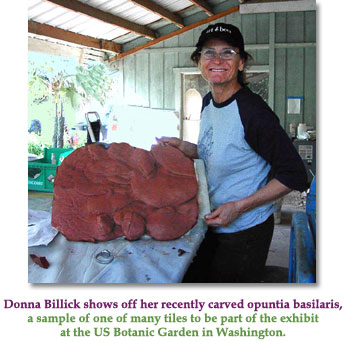
Fusing Tile Art with Science
at UC Davis and on the Mall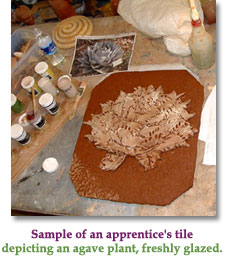
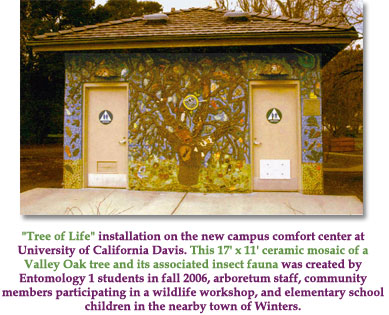 The Art/Science Fusion Program is committed to the concept that teaching and
learning are essentially experiences in sharing.
There are patterns, harmonies, symbols,
and perceptions that are shared across borders and disciplines, where knowledge and wisdom
unite and define who we are. The art/science fusion paradigm creates accessibility and
inclusion for people who would otherwise fear science, or fear art, and reaches for expression
within the classroom that creates value and a shared meaning system. Not only does the
paradigm provide a new and innovative classroom experience, it creates collaborations between
different kinds of students and the community. The learning outcomes for the undergraduate
students are extended to life-long learning opportunities for the public.
The Art/Science Fusion Program is committed to the concept that teaching and
learning are essentially experiences in sharing.
There are patterns, harmonies, symbols,
and perceptions that are shared across borders and disciplines, where knowledge and wisdom
unite and define who we are. The art/science fusion paradigm creates accessibility and
inclusion for people who would otherwise fear science, or fear art, and reaches for expression
within the classroom that creates value and a shared meaning system. Not only does the
paradigm provide a new and innovative classroom experience, it creates collaborations between
different kinds of students and the community. The learning outcomes for the undergraduate
students are extended to life-long learning opportunities for the public.
Turning Tiles “Green”
Part Two: Water
Just as building has a profound impact on our natural environment, so does our management of water resources. What does water have to do with Turning Tiles Green? It’s all about responsible stewardship. In my ongoing search for information and practical solutions to share, I found a very interesting resource, www.treehugger.com, from which I quote:
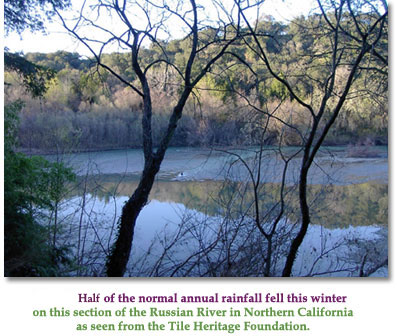
Water: What’s the Big Deal?
There is no resource more precious than water. There is also no resource that is misused, abused, misallocated, and misunderstood in such quantities. According to Joel Makower, executive editor of GreenBiz.com and a major advocate for a green economy, the world’s freshwater supply is at risk and the question is when and where, not whether, there will be major droughts or shortages that could have a major disruptive effect on business and society. Many people have had water-saving etiquette pumped into them at some point or other, so hopefully we can make a good case for conserving the stuff with some easy, everyday water-saving strategies as well as some more high-tech approaches.
Who’s Using What?
According to the EPA (www.epa.gov) the average American family of four uses 400 gallons per day, 30% of which is for outdoor uses and half of that for watering lawns–7 billion gallons per day. Many of the world’s citizens live on less than 2.5 gallons of water per day.
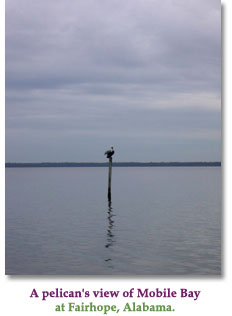
The World Water Forum made up of representatives from 130 nations reported in 2006 that farming accounts for 70% of the water used worldwide and most of it is wasted through primitive irrigation systems that are only 40% effective (see Wired:
www.wired.com). According to a 2002 article by Lester R. Brown, “Water Deficits Growing in Many Countries” (www.greatlakesdirectory.org), aquifers are depleting all over the world—in China, India and Mexico by 2-3 meters per year. In the US, the Ogallala aquifer beneath the Great Plains covering portions of eight states from South Dakota to Texas is shrinking rapidly. At www.ipsnews.net Unicef estimates that $11.3 billion are required to provide basic levels of service for drinking and waste water in Africa and Asia. In contrast, the amount spent on bottled water in the First World: $35 billion.
Again from www.treehugger.com, some tips: Stop the drips and leaks! Most are easy to fix. Install low-volume or dual flush toilets, low-flow shower heads, water-efficient dish and clothes washers. Begin to watch the water going down the drain where it ends up mixing with raw sewage, getting contaminated. Turn it off! Stay off the (plastic) bottle; bottled water is a study in itself! Where possible use cisterns to collect rain water and use it for garden or lawn irrigation. Water sources have to be protected. In many closed loop systems like those in cities around the Great Lakes, wastewater is returned to the Lake that fresh water comes out of. Don’t pour chemicals down drains, or flush drugs down toilets; they could come back in diluted form in your water.

Install ‘traps’ to keep clay and glaze waste out of your studio drains.
If you have a large operation and need to deal with a large volume of clay and glaze in wastewater, you will need a much more sophisticated system with inflow pipes, a settling tank and off-flow piping. For a studio, Vince Pitelka published directions for a do-it-yourself clay trap made from two plastic five gallon buckets in the November/December 2001 issue of Clay Times magazine. I’ve read that this trap works beautifully. The trap empties into a bucket, and the end water is hand-carried to a drain. Quite good water conservation! You let heavy clay and glaze remains settle out before pouring off the water. Generally, the water coming out of the trap is clean enough to reuse. E-mail Clay Tiles to locate the article: claytimesinfo@aol.com
Another place to ask questions and find answers
is CEER — Center for Environmental and Energy Research at Alfred University.
See ceer.alfred.edu
